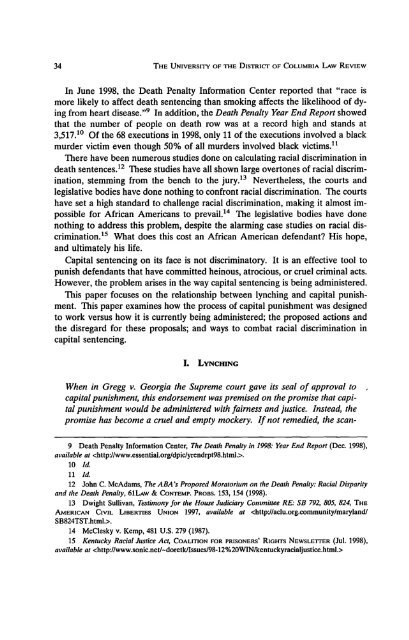The University of the District of Columbia Law ... - UDC Law Review
The University of the District of Columbia Law ... - UDC Law Review
The University of the District of Columbia Law ... - UDC Law Review
Create successful ePaper yourself
Turn your PDF publications into a flip-book with our unique Google optimized e-Paper software.
34 THE UNIVERSITY OF THE DISTRICf OF COLUMBIA LAW REVIEWIn June 1998, <strong>the</strong> Death Penalty Information Center reported that "race ismore likely to affect death sentencing than smoking affects <strong>the</strong> likelihood <strong>of</strong> dyingfrom heart disease.,,9 In addition, <strong>the</strong> Death Penalty Year End Report showedthat <strong>the</strong> number <strong>of</strong> people on death row was at a record high and stands at3,517. 10 Of <strong>the</strong> 68 executions in 1998, only 11 <strong>of</strong> <strong>the</strong> executions involved a blackmurder victim even though 500/0 <strong>of</strong> all murders involved black victims. I I<strong>The</strong>re have been numerous studies done on calculating racial discrimination indeath sentences. 12 <strong>The</strong>se studies have all shown large overtones <strong>of</strong> racial discrimination,stemming from <strong>the</strong> bench to <strong>the</strong> jury.13 Never<strong>the</strong>less, <strong>the</strong> courts andlegislative bodies have done nothing to confront racial discrimination. <strong>The</strong> courtshave set a high standard to challenge racial discrimination, making it almost impossiblefor African Americans to prevail. I4 <strong>The</strong> legislative bodies have donenothing to address this problem, despite <strong>the</strong> alarming case studies on racial discrimination.1s What does this cost an African American defendant? His hope,and ultimately his life.Capital sentencing on its face is not discriminatory. It is an effective tool topunish defendants that have committed heinous, atrocious, or cruel criminal acts.However, <strong>the</strong> problem arises in <strong>the</strong> way capital sentencing is being administered.This paper focuses on <strong>the</strong> relationship between lynching and capital punishment.This paper examines how <strong>the</strong> process <strong>of</strong> capital punishment was designedto work versus how it is currently being administered; <strong>the</strong> proposed actions and<strong>the</strong> disregard for <strong>the</strong>se proposals; and ways to combat racial discrimination incapital sentencing.I. LYNCHINGWhen in Gregg v. Georgia <strong>the</strong> Supreme court gave its seal <strong>of</strong> approval tocapital punishment, this endorsement was premised on <strong>the</strong> promise that capitalpunishment would be administered with fairness and justice. Instead, <strong>the</strong>promise has become a cruel and empty mockery. If not remedied, <strong>the</strong> scan-9 Death Penalty Information Center, <strong>The</strong> Death Penalty in 1998: Year End Report (Dec. 1998),available at .10 1d.11 1d.12 John C. McAdams, <strong>The</strong> ABA's Proposed Moratorium on <strong>the</strong> Death Penalty: Racial Disparityand <strong>the</strong> Death Penalty, 61LAW & CONTEMP. PROBS. 153, 154 (1998).13 Dwight Sullivan, Testimony for <strong>the</strong> House Judiciary Committee RE: SB 792, 805, 824, THEAMERICAN CIVIL LIBERTIES UNION 1997, available at .14 McClesky v. Kemp, 481 U.S. 279 (1987).15 Kentucky Racial Justice Act, COALmoN FOR PRISONERS' RIGHTS NEWSLETTER (Jul. 1998),available at














